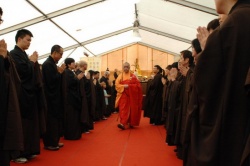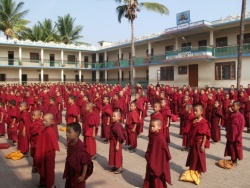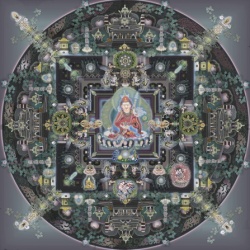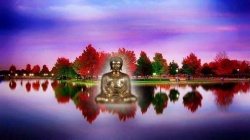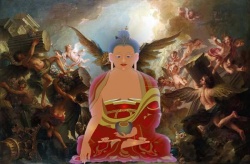Forty meditation subjects
The first ten kammatthana are "wholes" (kasina objects, things which one can behold directly):
(1) earth,
(2) water, (
3) fire,
(4) air, wind,
(5) blue, green,
(6) yellow,
(7) red,
(8) white,
(9) enclosed space,
(10) bright light.
The next ten are objects of repulsion (asubha):
(1) swollen corpse,
(2) discolored, bluish, corpse,
(3) festering corpse,
(4) fissured corpse,
(5) gnawed corpse,
(6,7) dismembered, or hacked and scattered, corpse,
(8) bleeding corpse,
(9) worm-eaten corpse,
(10) skeleton.
Ten are recollections (anussati):
First three recollections are of the virtues of the Three Jewels:
(1) Buddha
(2) Dharma
(3) Sangha
Next three are recollections of the virtues of:
(4) morality (sīla)
(5) liberality (cāga)
(6) the wholesome attributes of Devas
Recollections of:
(7) the body (kāya)
(8) death (see Upajjhatthana Sutta)
(9) the breath (prāna) or breathing (ānāpāna)
(10) peace (see Nibbana).
Four are stations of Brahma (Brahma-vihara):
(1) unconditional kindness (mettā)
(2) compassion (karuna)
(3) sympathetic joy over another's success (mudita)
(4) evenmindedness, equanimity (upekkha)
Four are formless states (four arūpajhānas):
(1) infinite space
(2) infinite consciousness
(3) infinite nothingness
(4) neither perception nor non-perception.
One is of perception of disgust of food (aharepatikulasanna).
The last is analysis of the four elements (catudhatuvavatthana): earth (pathavi), water (apo), fire (tejo), air (vayo).
Meditation subjects and jhanas
Jhāna-related factors. first jhāna second jhāna third jhāna fourth jhāna sensuality
(kāma),
unskillful
qualities
(akusala
dhamma) secluded
from,
withdrawn applied
thought
(vitakka) accompanies
jhāna stilled sustained thought
(vicāra) rapture
(pīti) seclusion-
born;
pervades
body samādhi-
born;
pervades
body fades
away
(as does
distress) pleasure
(sukha) pervades
physical body abandoned
(as is
pain) pure,
mindful
equanimity
(upekkhā-
sati-
pārisuddhi) [internal
confidence,
mental
unification] equanimous,
mindful neither
pleasure
nor pain;
permeates
body with
pure mind
Of these, due to their complexity, the first eight recollections, the perception of disgust of food and the analysis of the four elements only lead to access concentration (upacara samadhi).
Absorption in the first jhana can be realized by mindfulness on the ten kinds of foulness and mindfulness of the body. However, these meditations cannot go beyond the first jhana due to their involving applied thought (vitaka) which is absent from the higher jhanas.
Absorption in the first three jhanas can be realized by contemplating the first three brahma-viharas. However, these meditations cannot aid in attaining the fourth jhana due to the pleasant feelings associated with them. Conversely, once the fourth jhana is induced, the fourth brahma-vihara (equanimity) arises.
Due to the simplicity of subject matter, all four jhanas can be induced through mindfulness of breathing and the ten kasinas.
[edit] Meditation subjects and temperaments
All of the aforementioned meditation subjects can suppress the Five Hindrances, thus allowing one to fruitfully pursue wisdom. In addition, anyone can productively apply specific meditation subjects as antidotes, such as meditating on foulness to counteract lust or on the breath to abandon discursive thought.
The Pali commentaries further provide guidelines for suggesting meditation subjects based on ones general temperament:
Greedy: the ten foulness meditations; or, body contemplation.
Hating: the four brahma-viharas; or, the four color kasinas.
Deluded: mindfulness of breath.
Faithful: the first six recollections.
Intelligent: recollection of death or peace; the perception of disgust of food; or, the analysis of the four elements.
Speculative: mindfulness of breath.
The six non-color kasinas and the four formless states are suitable for all temperaments.
